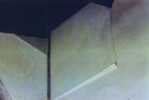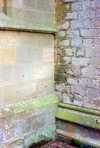 Whatton Whatton
St John of Beverley
Archaeology
The fabric of St John of Beverley is of two periods. Originally cruciform in plan, it has been reduced to its present form of chancel, nave and aisles in the nineteenth century.
The oldest part of the church is the north aisle and the nave arcades of octagonal pillars and double chamfered arches dating from the fourteenth century.
 At the east end of At the east end of
the north aisle |
The changes made in the nineteenth century spread from 1808 – when the south transept was removed and the south aisle pulled down and rebuilt – up to the end of the century.
Internally, apart from the east end of the north aisle, there is no visible evidence of change because the walls are plastered and whitewashed.
Following 1808 changes were made as follows:
 Non-matching Non-matching
plinths and
string course |
1846:the chancel was rebuilt, external evidence shows the use of machine cut and tooled masonry and a very simplified plinth and string course that does not match to the other fabric.
1858: the north porch rebuilt, smaller than before, the weathering of the original still apparent to the sides and above. The aisle plinth and string course cut into, as the porch is butt jointed to the aisle.
 Butt joint of Butt joint of
tower and
south aisle |
1871: major changes; tower rebuilt above first string course with a clear difference in stonework above and below, nave roof replaced and new clerestory windows. The stonework markedly different at this level, being sandstone in appearance. The exterior staircase on south side butt jointed to adjacent fabric.
1870s: south porch built, again butt jointed and cutting aisle plinth.
1880-90s: many windows replaced, particularly in chancel where a change in colour of stone shows where double light windows have been altered to single lancets.
 North aisle North aisle
east end
exterior |
Finally, 1956 when the east end of the north aisle was restored. It is not clear whether it was extended at this time or previously in the nineteenth century. Evidence of extension on the exterior shows where the aisle cuts into the Norman arch which was moved from the south side to the north side in the 1870 restoration. Also the plinth and lower string course inconsistent with the tower’s. The roof at this end also overlaps the tower and is higher than the rest of the aisle roof. Internally the south east corner shows a change in height and a possible corner of an old roof line and a ledge with no apparent function.
|